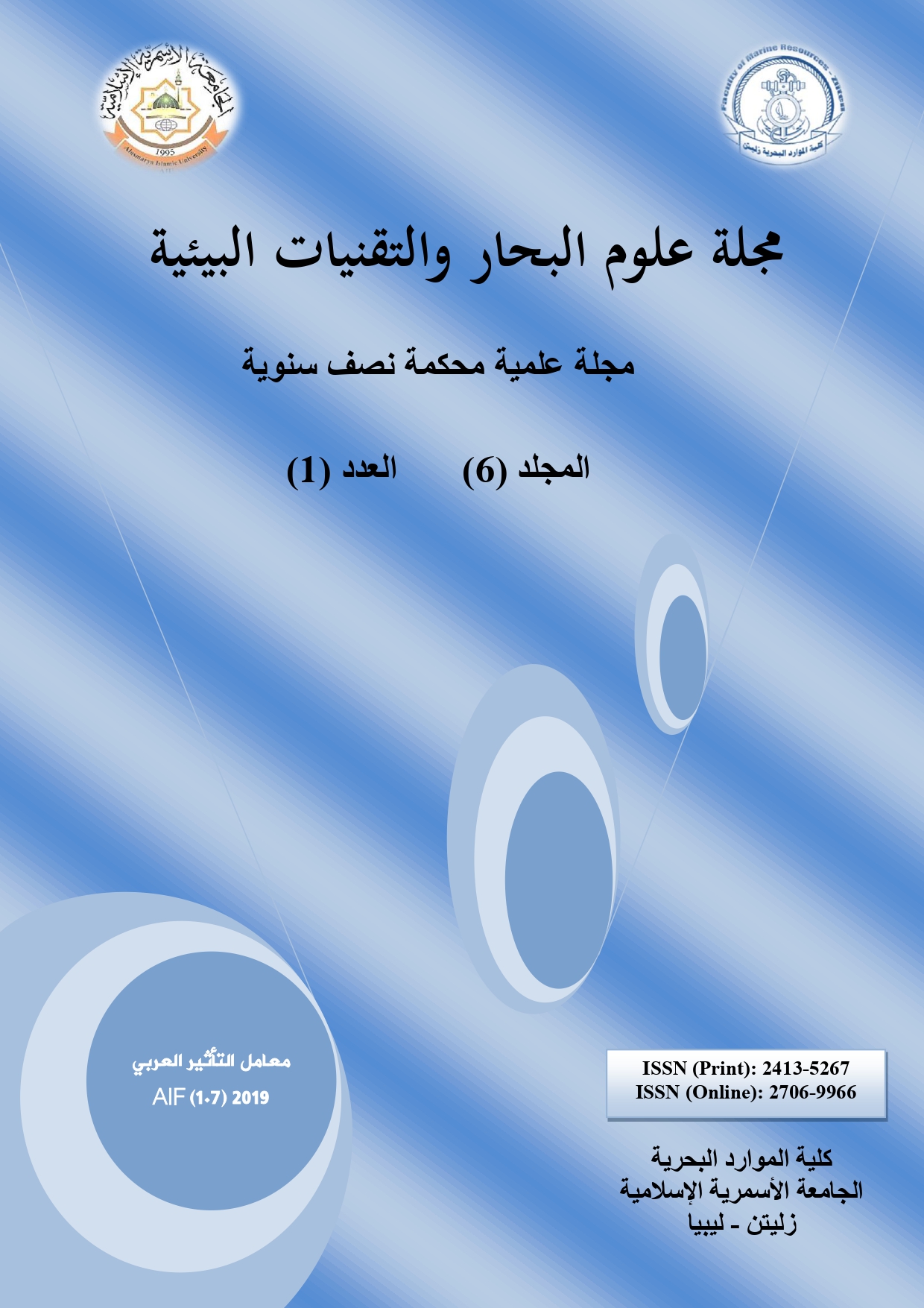تغذية سمكة السردين البلشارد الأوروبي (Walbaum, 1792) Sardina pilchardus في ساحل درنة، شرق ليبيا
DOI:
https://doi.org/10.59743/jmset.v6i1.46الكلمات المفتاحية:
الساحل الشرقي الليبي، تغذية، البحر الأبيض المتوسط، السردين Sardina pilchardus، ساحل درنة، ليبياالملخص
تم دراسة 700 عينة أسماك من أسماك السردين بولشارد Sardina pilchardus تم تجميعها خلال الفترة من أغسطس 2017 وحتى يوليو 2018م من ساحل درنة شرق ليبيا المطلة على البحر المتوسط، وكان للسمكة قائمة غذائية كبيرة تتكون من مجدافيات الأقدام (37.9%)، والكلادوسيرا (22.0%)، والدياتومات (5.2%)، وثنائيات الأسواط (14.1%)، ويرقات الديدان عديدة الأشواك (17.0%)، وبيوض القشريات (3.9%)، وهناك علاقة بين أحجام السمكة والعناصر الغذائية، فقد وجد أن احتياج السمكة من مجدافيات الأقدام والكلادوسيرا وبيوض القشريات ويرقات الديدان عديدة الأشواك يتزايد بزيادة طول السمكة والعكس صحيح تمامًا لثنائيات الأسواط والدياتومات، ولوحظ من الدراسة أن السمكة شديدة الاغتذاء في فصول الخريف والربيع والصيف.
المراجع
Abziew E.A.F. (2016). Fisheries statues in Derna coast, Eastern Libya. Int. J. Adv. Res. Biol. Sci., 3(4): 109-116.
Bat L., Erdem Y.S., Yardım, Ö, and Hüseyin S. (2005). A study on the fishes of the Ustaoğlu Central Black Sea Coast of Turkey. J. Black Sea/Mediterranean Environment, 11: 291-296.
Beaugrand G., Brander K.M., Lindley J.A., Souissi S., and Reid P. (2003). Plankton effect on cod recruitment in the North Sea. Nature, 426: 661-664.
Blaxter J.H.S., and Hunter J.R. (1982). The biology of the clupeoid fishes. Adv. Mar. Biol. 20: 1-223.
Borme D., Tirelli V., and Palomera I. (2013). Feeding habits of European pilchard late larvae in a nursery area in the Adriatic Sea. J. Sea Res., 78: 8-17.
Bulgakova Y.V. (1996). Feeding in the Black Sea anchovy: diet composition, feeding behaviour, feeding periodicity and daily rations. Sci. Mar., 60(Suppl 2): 283–284.
Checkley D., Alheit J., Oozeki Y., and Roy C. (2009). Climate change and small pelagic fish. Cambridge University Press, Cambridge, UK.
Costalago D., and Palomera I. (2014). Feeding of European pilchard (Sardina pilchardus) in the northwestern Mediterranean: from late larvae to adults. Scientia Marina, 78: 41–54.
Costalago D., and Palomera I. (2014). Feeding of European pilchard (Sardina pilchardus) in the northwestern Mediterranean: from late larvae to adults. Scientia Marina, 78(1): 41-54.
Cushing D.H. (1990). Plankton production and year-class strength in fish populations: an update of the match/mismatch hypothesis. Adv. Mar. Biol., 26: 249-293.
Demirhindi U. (1961). Nutrition of the sardine (Sardina pilchardus Walb.). Proceedings and Technical Papers of the General Fisheries Council for the Mediterranean. J. Mar. Sys., 111-112: 45-68 .
Durbin A.G. (1979). Food selection by plankton feeding fishes. Predator-prey systems in fisheries management, 203-218.
FAO-FIES. (2018). Aquatic Sciences and Fisheries Information System (ASFIS) species list. Available at: [htttps://www.fao.org/fishery/collection/asfis/en].
Frederiksen M., Edwards M., Richardson A.J., Halliday N.C., and Wanless S. (2006). From plankton to top predators: bottom-up control of a marine food web across four trophic levels. J. Anim. Ecol., 75: 1259-1268.
Gerking S. (1994). Feeding ecology of fish. Academic Press, San Diego, US.
Godfriaux B.L. (1969). Food of predatory demersal fish in Hauraki Gulf: 1: Food and feeding habits of snapper. New Zealand Journal of Marine and Freshwater Research, 3(4): 518-544.
Honda H. (1984). Food acquisition patterns in some demersal telosts, Tohoku. J. Agric. Res. 35(1): 33-54.
Hynes H.B. (1985). The food of fresh water. The feeding of juvenile striped sea bream, Lithognathus mormyrus (L.) in the Central Adriatic Sea (Pisces, Sparidae). Rapp. Comm. Int. Mer Médit, 29: 107-108.
Hyslop E.J. (1980). Stomach content analysis: Review of methods and their application. J. Fish. Biol., 17: 411-429.
James A.G. (1986). Are clupeid microphagists herbivorous or omnivorous? A review of the diets of some commercially important clupeids. S. Afr. J. Mar. Sci., 7(1): 61-177.
Lebour M.V. (1921). The food of young clupeoids. J. Mar. Biol. Ass UK, 12(3): 458-467.
Madkour F.F. (2011). Feeding ecology of the round sardinella, Sardinella aurita (Family: Clupeidae) in the Egyptian Mediterranean waters. IJESE, 2: 83-92.
Nikolioudakis N., Isari S., Pitta P., Somarakis S. (2012). Diet of sardine Sardina pilchardus and end-to-end’ field study. Mar. Ecol. Prog. Ser., 453: 173-188.
Nikolioudakis N., Palomera I., Machias A., Somarakis S. (2011). Diel feeding intensity and daily ration of the sardine Sardina pilchardus. Mar. Ecol. Prog. Ser., 437: 215-228.
Nunn A.D., Harvey J.P., and Cowx I.G. (2007). Variations in the spawning periodicity of eight fish species in three English lowland rivers over a 6-year period, inferred from 0+ year fish length distributions. J. Fish Biol., 70: 1254–1267.
Oronsaye C.G., and Nakpodia F.A. (2005). A comparative study of the food and feeding habits of Chrysichthys nigodigitatus (Lacepede) and Brycinus nurse in a Tropical River. Pakistan Journal of Scientific and Industrial Research, 48(2): 118–121.
Palomera I., Olivar M.P., Salat J., Sabates A., Coll M., Garcia A., and Morales-Nin B. (2007). Small pelagic fish in the NW Mediterranean Sea: an ecological review. Progr. Oceanogr., 74(2-3): 377-396.
Pauly D., and Christensen V. (2000). Trophic Levels of Fishes. In: Froese R., Pauly D. (editors). Fish Base: Concepts, Design and Data Sources. Manila, Philippines.
Pillay T.V.R. (1952). A critique of the methods of study of food of fishes. J. Zool. Soc. India, 4: 181-199.
Post D.M., Pace M.L., and Hairston N.G. (2000). Ecosystem size determines food-chain length in lakes. Nature, 405(6790):1047-1049.
Shalloof K., and Khalifa N. (2009). Stomach Contents and Feeding Habits of Oreochromis niloticus (L.) From AbuZabal Lakes, Egypt. World Applied Journal of Science, 6: 01-05.
Van der Lingen C.D. (1994). Effect of particle size and concentration on the feeding behavior of adult pilchard Sardinops sagax. Mar. Ecol. Prog. Ser., 109: 1-13.
Wainwright P.C., and Richard B.A. (1995). Predicting patterns of prey use from morphology of fishes. Env. Biol. Fish., 44: 97-113.
Wassef E.A., and Eisawy A. (1985). Food and feeding habit, of wild and reared gilthead bream Sparus aurita (L.). Cybium 9(3): 233-242.
Wootton R.J. (1990). Ecology of Teleost Fishes. Chapman and Ha-Hall London.
التنزيلات
منشور
إصدار
القسم
الرخصة
الحقوق الفكرية (c) 2020 مجلة علوم البحار والتقنيات البيئية

هذا العمل مرخص بموجب Creative Commons Attribution 4.0 International License.









